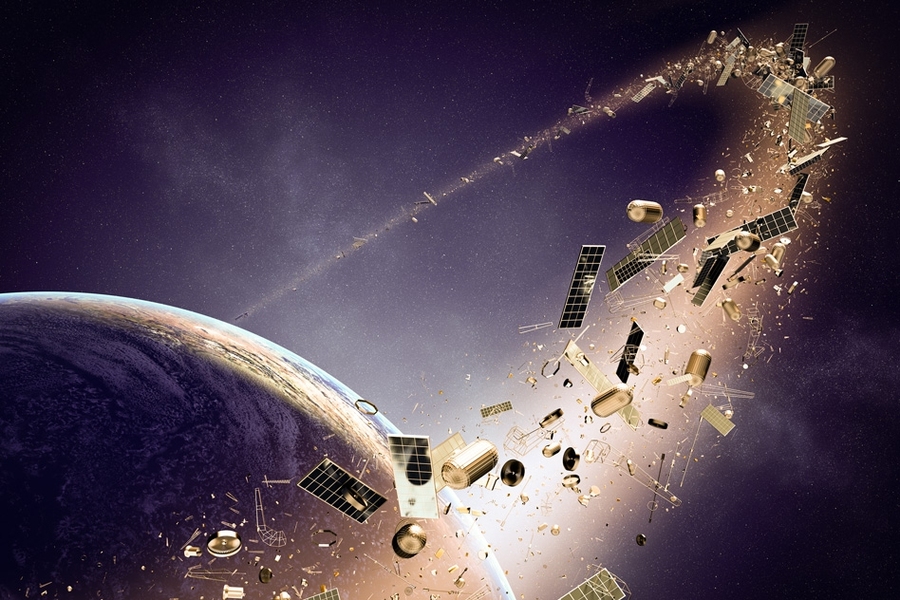The expanse of space is frequently depicted as an empty void, but in truth, it is home to an escalating issue: Space Debris. The European Space Agency estimates that there are more than 128 million fragments of debris in orbit, with countless more too diminutive to be detected. This debris is a danger to satellites, spacecraft, and astronauts, and is becoming an increasingly pressing concern. In this blog entry “Space Debris”, we will delve into the urgent necessity for proficient space debris management, as well as the measures being taken to tackle this problem.

The environment of space is being filled with a steadily increasing issue: space debris. Recent research from the European Space Agency identifies that there are more than 128 million pieces of debris in orbit and even more that are too small to be monitored.
Table of Contents
What are the Issues Surrounding Space Debris?
There is a large amount of debris in space, such as non-operational spacecraft, used rocket stages, and pieces from explosions and collisions. These objects have the potential to travel at a velocity of up to 17,500 miles per hour, which can cause serious harm to anything they come into contact with. Even the smallest particles can cause massive destruction, as witnessed in 2009 when a Russian satellite that was no longer in service crashed into an active Iridium one, creating thousands of extra bits of debris.
The ramifications of space junk reach far and wide. The ISS faces persistent danger of a potential crash with debris, and this can impede the feasibility of space exploration. Furthermore, some of the debris can survive re-entry into the atmosphere, thus presenting a threat to Earth’s surface.
The urgency of managing space debris is unmistakable, yet the magnitude of the task makes it a difficult endeavor.
What Steps are Being Taken to Resolve the Problem?
The problem of space debris is being actively addressed with various organizations developing strategies to tackle it.
To reduce the risk of new debris, the Inter-Agency Space Debris Coordination Committee (IADC) has established suggestions for spacecraft design and operation. These guidelines include limiting the release of materials at launch and decommissioning spacecraft after their service life.
A different method to deal with existing space debris is to take it out of orbit. Technologies are being crafted for this goal, such as nets, harpoons, and robotic arms. The European Space Agency’s Clean Space plan is to produce new technologies to eliminate space debris, including a mission to seize and bring down an abandoned satellite.
The United Nations Committee on the Peaceful Uses of Outer Space (COPUOS) has formulated guidelines and protocols for the management of space debris. Additionally, the Space Data Association, a global body of satellite operators, shares information on debris to minimize the risk of collisions. International collaboration is essential for effective debris management.
In Closing
In conclusion, it can be said that…
The urgency of Lost in Space is clear. Effective space debris management must be implemented to guarantee the safety and success of space exploration. While there are ongoing initiatives to address this issue, much more must be done to lessen the peril posed by space debris. This includes limiting the production of new debris, eliminating existing debris, and fostering international collaboration. Thus, we can strive for a safer and more sustainable space environment. To acquire more knowledge about the latest technology, visit this website and you also visit this link.
The presence of carbon dioxide in the atmosphere is a major factor in global warming. This gas is released by the burning of fossil fuels, and its increasing levels are causing temperatures to rise. As it accumulates, it serves as a blanket, trapping heat and contributing to the climate change that is already being experienced around the world.
The presence of carbon dioxide in the atmosphere is having a major effect on global warming. This gas is released when fossil fuels are burned, and an increase in its levels has led to rising temperatures. As it builds up, it acts like a blanket, trapping the heat and intensifying the climate change that the world is already feeling. For more information please visit

